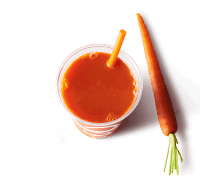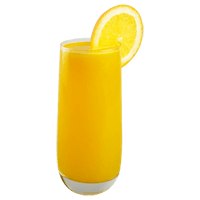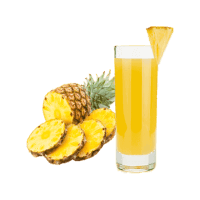Aloe vera juice nutrition: calories, carbs, GI, protein, fiber, fats
Beverages, aloe vera juice drink, fortified with Vitamin C
*all the values are displayed for the amount of 100 grams
Important nutritional characteristics for Aloe vera juice

| Calories ⓘ Calories per 100-gram serving | 15 |
| Net Carbs ⓘ Net Carbs = Total Carbohydrates – Fiber – Sugar Alcohols | 3.75 grams |
| Serving Size ⓘ Serving sizes are taken from FDA's Reference Amounts Customarily Consumed (RACCs) | 8 fl oz (240 grams) |
| Acidity (Based on PRAL) ⓘ PRAL (Potential renal acid load) is calculated using a formula. On the PRAL scale the higher the positive value, the more is the acidifying effect on the body. The lower the negative value, the higher the alkalinity of the food. 0 is neutral. | -0.1 (alkaline) |
Vitamin C ⓘHigher in Vitamin C content than 69% of foods
Sugar ⓘHigher in Sugar content than 48% of foods
Net carbs ⓘHigher in Net carbs content than 40% of foods
Carbs ⓘHigher in Carbs content than 37% of foods
Calcium ⓘHigher in Calcium content than 18% of foods
Aloe vera juice calories (kcal)
| Serving Size | Calories | Weight |
|---|---|---|
| Calories in 100 grams | 15 | |
| Calories in 8 fl oz | 36 | 240 g |
Mineral coverage chart
Calcium:
8 mg of 1,000 mg
1%
Iron:
0.15 mg of 8 mg
2%
Magnesium:
0 mg of 420 mg
0%
Phosphorus:
0 mg of 700 mg
0%
Potassium:
0 mg of 3,400 mg
0%
Sodium:
8 mg of 2,300 mg
0%
Zinc:
0 mg of 11 mg
0%
Copper:
0 mg of 1 mg
0%
Manganese:
0 mg of 2 mg
0%
Selenium:
0 µg of 55 µg
0%
Choline:
0 mg of 550 mg
0%
Mineral chart - relative view
Calcium
8 mg
TOP 82%
Sodium
8 mg
TOP 87%
Iron
0.15 mg
TOP 91%
Choline
0 mg
TOP 100%
Selenium
0 µg
TOP 100%
Copper
0 mg
TOP 100%
Zinc
0 mg
TOP 100%
Potassium
0 mg
TOP 100%
Phosphorus
0 mg
TOP 100%
Magnesium
0 mg
TOP 100%
Vitamin coverage chart
Vitamin A:
0 IU of 5,000 IU
0%
Vitamin E :
0 mg of 15 mg
0%
Vitamin D:
0 µg of 10 µg
0%
Vitamin C:
3.8 mg of 90 mg
4%
Vitamin B1:
0 mg of 1 mg
0%
Vitamin B2:
0 mg of 1 mg
0%
Vitamin B3:
0 mg of 16 mg
0%
Vitamin B5:
0 mg of 5 mg
0%
Vitamin B6:
0 mg of 1 mg
0%
Folate:
0 µg of 400 µg
0%
Vitamin B12:
0 µg of 2 µg
0%
Vitamin K:
0 µg of 120 µg
0%
Vitamin chart - relative view
Vitamin C
3.8 mg
TOP 31%
Vitamin K
0 µg
TOP 100%
Vitamin A
0 IU
TOP 100%
Vitamin B12
0 µg
TOP 100%
Folate
0 µg
TOP 100%
Vitamin B6
0 mg
TOP 100%
Vitamin B3
0 mg
TOP 100%
Vitamin B2
0 mg
TOP 100%
Vitamin B1
0 mg
TOP 100%
Vitamin D
0 µg
TOP 100%
Vitamin E
0 mg
TOP 100%
Macronutrients chart
Protein:
Daily Value: 0%
0 g of 50 g
0%
Fats:
Daily Value: 0%
0 g of 65 g
0%
Carbs:
Daily Value: 1%
3.75 g of 300 g
1%
Water:
Daily Value: 5%
96.23 g of 2,000 g
5%
Other:
0.02 g
Fiber content ratio for Aloe vera juice
Sugar:
3.75 g
Fiber:
0 g
Other:
0 g
All nutrients for Aloe vera juice per 100g
| Nutrient | Value | DV% | In TOP % of foods | Comparison |
| Calories | 15kcal | 1% | 98% |
3.1 times less than Orange
|
| Protein | 0g | 0% | 100% |
N/A
|
| Fats | 0g | 0% | 100% |
N/A
|
| Vitamin C | 3.8mg | 4% | 31% |
13.9 times less than Lemon
|
| Net carbs | 3.75g | N/A | 60% |
14.4 times less than Chocolate
|
| Carbs | 3.75g | 1% | 63% |
7.5 times less than Rice
|
| Cholesterol | 0mg | 0% | 100% |
N/A
|
| Vitamin D | 0µg | 0% | 100% |
N/A
|
| Iron | 0.15mg | 2% | 91% |
17.3 times less than Beef broiled
|
| Calcium | 8mg | 1% | 82% |
15.6 times less than Milk
|
| Potassium | 0mg | 0% | 100% |
N/A
|
| Magnesium | 0mg | 0% | 100% |
N/A
|
| Sugar | 3.75g | N/A | 52% |
2.4 times less than Coca-Cola
|
| Fiber | 0g | 0% | 100% |
N/A
|
| Copper | 0mg | 0% | 100% |
N/A
|
| Zinc | 0mg | 0% | 100% |
N/A
|
| Phosphorus | 0mg | 0% | 100% |
N/A
|
| Sodium | 8mg | 0% | 87% |
61.3 times less than White Bread
|
| Vitamin A | 0IU | 0% | 100% |
N/A
|
| Vitamin A RAE | 0µg | 0% | 100% | |
| Vitamin E | 0mg | 0% | 100% |
N/A
|
| Selenium | 0µg | 0% | 100% | |
| Vitamin B1 | 0mg | 0% | 100% |
N/A
|
| Vitamin B2 | 0mg | 0% | 100% |
N/A
|
| Vitamin B3 | 0mg | 0% | 100% |
N/A
|
| Vitamin B6 | 0mg | 0% | 100% |
N/A
|
| Vitamin B12 | 0µg | 0% | 100% |
N/A
|
| Vitamin K | 0µg | 0% | 100% |
N/A
|
| Folate | 0µg | 0% | 100% |
N/A
|
| Trans Fat | 0g | N/A | 100% |
N/A
|
| Saturated Fat | 0g | 0% | 100% |
N/A
|
| Monounsaturated Fat | 0g | N/A | 100% |
N/A
|
| Polyunsaturated fat | 0g | N/A | 100% |
N/A
|
| Omega-3 - EPA | 0g | N/A | 100% |
N/A
|
| Omega-3 - DHA | 0g | N/A | 100% |
N/A
|
| Omega-3 - DPA | 0g | N/A | 100% |
N/A
|
Check out similar food or compare with current
NUTRITION FACTS LABEL
Nutrition Facts
___servings per container
Serving Size ______________
Serving Size ______________
Amount Per 100g
Calories 15
% Daily Value*
0%
Total Fat
0g
0%
Saturated Fat 0g
0%
Cholesterol 0mg
0%
Sodium 8mg
1%
Total Carbohydrate
4g
0%
Dietary Fiber
0g
Total Sugars g
Includes ? g Added Sugars
Protein
0g
Vitamin D
0mcg
0%
Calcium
8mg
1%
Iron
0mg
0%
Potassium
0mg
0%
*
The % Daily Value (DV) tells you how much a nutrient in a serving of food contributes to a daily diet. 2,000 calories a day is used for general nutrition advice.
Health checks
Low in Cholesterol
ⓘ
Dietary cholesterol is not associated with an increased risk of coronary heart disease in healthy individuals. However, dietary cholesterol is common in foods that are high in harmful saturated fats.
Source
No Trans Fats
ⓘ
Trans fat consumption increases the risk of cardiovascular disease and mortality by negatively affecting blood lipid levels.
Source
Low in Saturated Fats
ⓘ
Saturated fat intake can raise total cholesterol and LDL (low-density lipoprotein) levels, leading to an increased risk of atherosclerosis. Dietary guidelines recommend limiting saturated fats to under 10% of calories a day.
Source
Low in Sugars
ⓘ
While the consumption of moderate amounts of added sugars is not detrimental to health, an excessive intake can increase the risk of obesity, and therefore, diabetes.
Source
Aloe vera juice nutrition infographic

Infographic link
References
All the values for which the sources are not specified explicitly are taken from FDA’s Food Central. The exact link to the food presented on this page can be found below.


